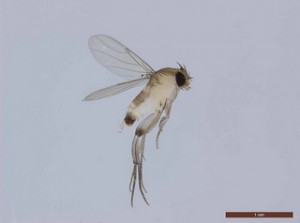Phorid Flies – How to Find a Sewer Line Break
By Chris Williams on March 3, 2013.
Question
 We’ve had an ongoing problem with little flies that we’re told are phorid flies. A pest control company has sprayed our house twice and it seemed to help for a couple of weeks, but the flies always came back. I’ve looked them up on the Internet and it seems they are often associated with broken sewer lines. How can we find out if that’s where they’re coming from? Do we have to tear up the whole floor to check and where would we start?
We’ve had an ongoing problem with little flies that we’re told are phorid flies. A pest control company has sprayed our house twice and it seemed to help for a couple of weeks, but the flies always came back. I’ve looked them up on the Internet and it seems they are often associated with broken sewer lines. How can we find out if that’s where they’re coming from? Do we have to tear up the whole floor to check and where would we start?
Answer
You’re right that phorid flies are often associated with sewer breaks under a slab. I assume you and your pest control company have ruled out other breeding sites for the flies. Phorid fly larvae feed on a range of disgusting things: dead animals, insects, rotting plant material, and animal feces. They even feed on human corpses. Besides sewer breaks, other phorid fly infestation sites in homes include clogged drains, dirty garbage cans, scummy drip pans under refrigerators or air conditioners, wet potted plants or rotting cut flowers, accumulations of dead insects, or a dead mouse or other animal.
Large infestations indoors are most often associated with broken septic or sewer lines. When a sewer line breaks, perhaps from invading tree roots or settling ground, sewage can accumulate under a slab or crawl. Phorid flies escape from the sewer lines and then breed in the organic “goo” that leaks from the broken pipe. They can build up high populations underground before anyone realizes there’s a problem. But if adult flies find a route to light, perhaps through a crack in a slab or an open expansion joint, hundreds of flies per day can enter the home above.
There are three ways to locate sewer breaks under a slab without opening up the slab: leak tests, smoke tests, and video inspection. All require the services of a plumber. The leak test is a low tech method of finding a sewer line break under a slab. It doesn’t always work, but it is inexpensive. First, a plumber blocks the sewer line at the manhole or at a cleanout closest to the manhole. Water is run into sinks, floor drains, etc. to fill all the pipes under the slab. Then you wait to see if water drains out of any sink cleanout, etc. If it does, it signals a break between that location and the closest downhill point of the drain system that is still holding water.
A smoke test uses a smoke generator and a blower to force a dense, nontoxic smoke through the lines. Smoke should be visible coming out of roof vents, drill holes, expansion joints, and poorly fitted caps on cleanouts and drains. The location and intensity of the smoke will help pinpoint the location of a break in the line.
In a video test, a miniature camera is threaded through the sewer pipes to locate breaks. The major limitation of video inspection is the inability to get the camera into all of the small pipes under the slab. Video inspection can be expensive but the advantage to this test is that when you see a break with the camera, you know the exact location of the problem.
Unfortunately, finding a sewer line break doesn’t end your problems. And, it’s not as simple as simply repairing the break. All of the contaminated soil must be removed because a very small quantity of contaminated soil can support a large population of phorid flies.